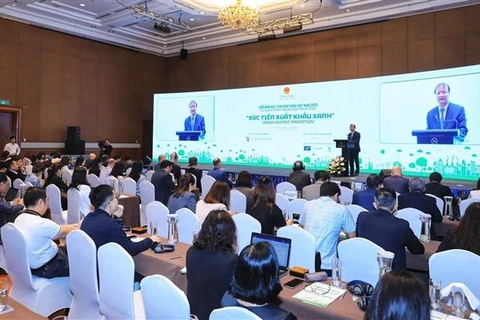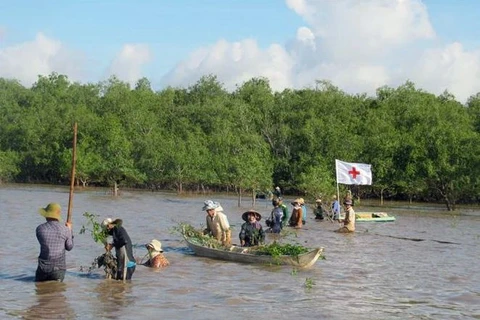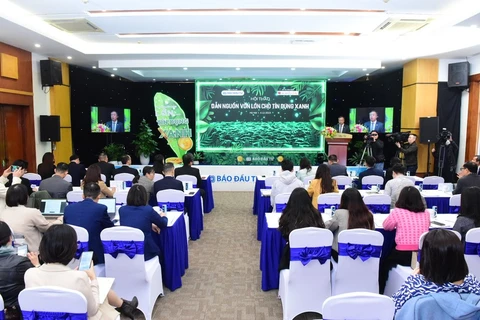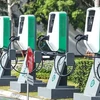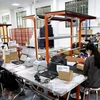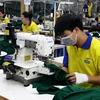Hanoi (VNA) – Digital economy, circular economy and green growth have been opted by many countries, meaning businesses should be prepared for new trends to raise their competitiveness and boost sustainable exports.
The slow economic recovery globally has exerted strong impacts on many key exports of Vietnam last year. Therefore, meeting the high standards of markets and customers on green, sustainable development is the prerequisite to increase values and maintain the position of exports in the context of the increasingly fierce competition.
Falling orders, fierce competitions
The Ministry of Industry and Trade (MoIT) reported that since 2023, persistent inflation in major markets have caused orders to drop, directly impacting Vietnamese exporters.
In the first quarter of 2023 alone, Vietnam’s exports contracted by 11.9% year-on-year, reflecting the gloomy picture of domestic production.
2023 also marked the first year when garment-textile exports slumped some 10% mainly due to the declining demand and falling prices of orders, down more than 30% on average.
The ministry said last year, the total export turnover of processed industrial goods was estimated at 301.56 billion USD, down 5.5% year-on-year.
Notably, five out of the seven members of the over 10-billion-USD club experienced decreases in export revenue, including phones and components; machinery, equipment, tools and other spare parts; garments-textiles; footwear; and wood and timber products.
 The leather and footwear sector has many advantages generated by free trade agreements. (Photo: VietnamPlus)
The leather and footwear sector has many advantages generated by free trade agreements. (Photo: VietnamPlus) Over the past years, such big markets as the US and the European Union (EU) have faced great inflation pressure, causing their consumers to tighten their purse string, thus resulting in the reduction of imports of non-essential consumer goods.
Besides, many importers have set high requirements for sustainable development and environmentally friendly production, pushing Vietnamese products and goods in fiercer competitions.
Focusing on sustainable development
Against the backdrop, concerned agencies, including the MoIT, have taken various solutions to remove obstacles to exports, such as increasing trade promotion activities, and maximising bilateral and multilateral FTAs.
Such efforts paid off as industrial production bounced back, especially in the last months of 2023, with its index in the year rising by 1.5% year-on-year.
The best performers in this regard included Bac Giang, Quang Ninh, Hai Phong, Tra Vinh, Ha Nam and Ninh Thuan which posted double-digit gains, ranging from 13.2% to 20.3%.
Meanwhile, agriculture enjoyed a “bumper harvest” with total export value exceeding 53 billion USD, and trade surplus hitting the record high of over 12 billion USD, up 43.7%. More than 10 items joined the more than 1-billion-USD club in the year.
Notably, the country ran a record trade surplus of 28 billion USD last year, more than doubling the figure recorded in the previous year.
 Green production offers opportunities for businesses to participate deeply in supply chains. (Photo: VietnamPlus)
Green production offers opportunities for businesses to participate deeply in supply chains. (Photo: VietnamPlus) Vu Ba Phu, Director of the Vietnam Trade Promotion Agency (Vietrade) under the Ministry of Industry and Trade (MoIT), suggested relevant ministries and agencies supplement and consolidate the legal framework, and set out standards and regulations on green transition for each sector in order to help enterprises optimise market opportunities and satisfy higher standards of importers.
Other experts stressed the need for businesses to diversify their trade partners, evaluate risks, put forth scenarios and carbon reduction strategies, participate in carbon offset projects, evaluate carbon intensity, invest in innovation and technology and engage in industrial cooperation initiatives, in order to ensure sustainable exports./.

